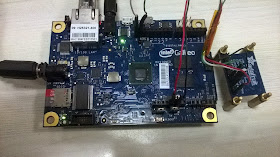This blog explain you on how to connect the Adafruit 10DOF
IMU (A combo board provides 3-axis gyro, 3-axis compass, barometric pressure
and temperature sensors) to Galileo Gen 1 board using Windows
IoT. I bought this sensor board for some other purpose but I found it is also
Arduino compatible, so I tried with Galileo and succeeded.
Components
- · Intel Galileo Gen1
- · DB9 Female to 3.5mm Cable (UART used to print the sensor values)
- · Visual studio 2013 with Windows IoT SDK (Visit: windowsondevices.com for more details) and Galileo C++ SDK NuGet Package is required.
Interfacing
10DOF IMU board is connect to Galileo through I2C interface.
It needs 5V power and SDA and SCL is also 5V pins. See the below block diagram
for the connectivity.
Figure 1) Galileo gen 1 with
Adafruit 10 DOF IMU wiring
Figure b) Galileo Gen
1 with 10 DOF IMU module
How to make it work
Since this module has the combination of sensors, you can
find the each sensor source code separately from the Adafruit’s github. Here is
the links,
https://github.com/adafruit/Adafruit_Sensor
(only Adafruit_Sensor.h is required)
Building
I created a “Galileo Wiring App” application and included
the required .cpp and .h files, which I downloaded from the above listed Adafruit
github. I did few modification to resolve some compilation errors and just
mapped the code from tester.pde file to main.cpp of my application since it is
following the same ArdunioSketch.
This application read the data
from sensors and print it on serial port. I used the debug UART for printing
messages. Since it is mapped for kernel debugger you have to do some changes in
bcd file as mentioned in the topic “Allow UART to be used for HardwareSerial (This will
change it from kernel debugger use)”
to use it as a serial port in OS. This port is COM2, HardwareSerial Serial1 Object is mapped
to COM2. I changed the source code to use this port.
I also noticed that the
carriage return (\r) is missed in the println() and caused the printed messages
unaligned. So I just added the ‘\r’ on the below code in the path “\packages\Microsoft.IoT.Galileo.Arduino.1.0.6\build\native\include\print.h”.
Of course it is part of the “Galileo C++ SDK” package.
Testing
Set the serial port terminal application (I am using Tera Term) for the baud rate 115200, 8bit, Parity N, Stop bit 1 and Flow control as
N. Run the application from Visual studio through remote debugger. Here is the
output on Tera Term.
Figure 3) Application sending sensors data to serial port continuously
Source code
You can find the source code of this application from the
below codeplex link.
I am a WinCE guy and Of course this my first experience with
Galileo/Ardunio wiring application development and it took less than an hour
for this work. It is really a cool stuff. Enjoy !!!.



No comments:
Post a Comment